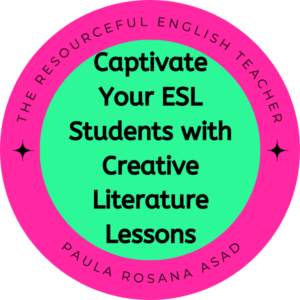Captivate Your ESL Students with Creative Literature Lessons | EFL
Are you eager to captivate your students’ interest in literature? Fortunately, there are various creative literature lessons at your disposal to get your students excited about. The advantages of using literature in class are endless, and before we delve deeper, let’s recognize its amazing benefits in English Language Teaching (ELT).

The Benefits
- It provides a great deal of input and can be a rich source for speaking and writing. Language becomes more visible and students can easily notice how words are used in context.
- It promotes reading habits, and improves reading skills.
- It can trigger creativity and spark imagination.
- It expands knowledge and opens up the mind, as a result, it helps us develop new concepts and ideas.
- It is a fantastic way to expose learners to authentic material and it brings cultural awareness, as literature and culture are well-bound together.
Creative Literature Lessons
Performance Poetry 💚
This is poetry that is meant to be performed in front of an audience. It went against the standard structures and forms of traditional poetry, such as sonnets. Instead, this genre of poetry experimented with different rhythms to engage the audience and convey the poem’s meaning. It paved the way for slam poetry. Slam Poetry: A competitive form of spoken word poetry.
Check out these poems being performed:
- Chocolate Cake by Michael Rosen
- When Love Arrives by Sarah Kay & Phil Kaye
- Talking Turkeys by Benjamin Zephania
- The British by Benjamin Zephania
- Revolting Rhymes – The three little Pigs read by Roald Dahl
Blackout Poetry 💚
The concept is simple. Students take a page of words that can be ripped from a magazine, or a newspaper, and then they choose some words or phrases inside. Next, they piece them together into a poem. Then they blackout the rest with a marker. This is great for those students who don’t usually have ideas or feel they cannot create anything. And let me tell you a secret, creativity arrives when teachers provide some scaffolding and constraints.
Six-Word Stories 💚
Show examples of what a Six-Word Story is. Check some examples HERE. Then, you can give students a prompt/question to help them write their six-word story. The question might be as simple as “Can you describe your holidays in 6 words?” The constraint of six words would fuel creativity!
Mini Sagas! 💚
A mini-saga is a short story that has exactly 50 words (not including the title). The 50 words must create a complete story. They are a great stepping stone to writing short stories. Provide students with examples of min sagas, click HERE. Then, give them some prompts (pictures, topics, paintings) and ask them to write their first drafts. Once their drafts are edited you can display, and publish the final versions of their sagas!
Change the location! 💚
Ask students to read a story they like and then ask them to change the setting. By changing locations students can make connections with geography and can recreate another story taking into account what can be found in that place! Ask them to share their plot twists with the rest of the class. Have fun!
Comic Strips 💚
They are a great source of material for teachers. With comics, learners can be exposed to a variety of genres, styles, collocations, and informal language. Comics explore humor and language so they are ideal for upper-intermediate or advanced learners of English. Check out Mafalda in English for sparking debate and developing critical thinking. CLICK HERE!
Speed-date 💚
Students select a character from the novel. They create a unique name design using symbols that reflect the character’s conflicts, goals, growth, and personality traits. They present their name designs to small groups in a fun, speed dating-style format, where they spend 3-5 minutes discussing their character’s symbols with a new partner.
Human Statues 💚
This activity is great for demonstrating sequencing and summarization of a story. After reading a story, students get divided into groups of 4 – 5 and choose three critical moments from the reading they want to recreate. The students communicate those key moments by creating a composition through body language and facial expressions, just as if they were human statues. The teacher asks the audience to close their eyes and cues them with “blackout.” During this time, the group quickly and silently forms their first scene. When ready, students open their eyes and view the scene as they hold it for a few seconds. Then, the same procedure is repeated until all three scenes are recreated. Finally, the class is given 10 minutes to write what they saw and how they can connect each scene with the different moments in the story.
Univocalic Poems 💚
They are a unique type of poetry where you use only one vowel throughout the entire poem. It’s a fun and creative exercise for your students. They can enjoy the process of gathering words that contain only one vowel and then using them to craft a short poem. The best part is that there are no limits to their imagination – the poem can be as wild, twisted, and wacky as they want it to be! Example: “Love knows about forever joy”
Alright, I hope you’ve found a bunch of creative lesson ideas for how to pull your students into literature. Literature sparks students’ imagination and opens their minds to the beauty of words. Also, it provides the perfect playground to explore real language and connect with diverse cultures, creating a rich and immersive learning experience. So, what are you waiting for? Any novel, story in mind?

